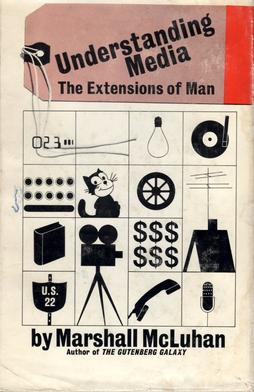


コミュニケーション能力をつけるのではなく
コミュニケーションのパワーを使うのだ!
An Inquiry for Power of Communication
Mitzub'ixi Qu'q Ch'ij
"This now brings us to the factual core of the "pseudoevent," a label applied to the new media, in general, because of their power to give new patterns to our lives by acceleration of older patterns. It is necessary to reflect that this same insidious power was once felt in the old media, including languages. All media exist to invest our lives with artificial perception and arbitrary values." -McLuhan, Understanding media.
「擬似イベント」これは、古いパターンを
加速させることで、私たちの生活に新しいパターンを与える力があることから、新しいメディア全般につけられるレッテルである。これと同じ陰湿な力が、かつ
て言語を含む古いメディアにも感じられたことを振り返る必要がある。すべてのメディアは、私たちの生活に人工的な知覚と恣意的な価値を与えるために存在し
ている。——マクルーハン『メディアの理解』
コミュニケーションの能力をつけるには、とビジネスパースン 向けのサイトには、次のようなことが書いている。コミュニケーション能力とは「人の 気持ちや感情をくみ取りながら、意思疎通ができる力」であり「私たちが生きていく上で大切な「人間関係」を築く力」だという(出典:恥ずかしいので ここでリンクして晒すことにする)。最初はジョークだと思ったよ、俺は。これは、なにかの努力(引用したサイトには、コミュニケーションは「伝え ること」と「受け取ること(=聴くこと)」なので、 そこに書いてあることを実行すれば)をすれば、コミュニケーション能力がつくと宣っている。僕はバカバカしくおかしくて笑いがとまならない。「対話が重要 である」というの馬鹿、あたり前だからである。対話には、目的論をとれば、「よい対話」と「わるい対話」の2種類しかなく、それ以外は「対話のフリをしたモノローグである」
つまり、うんこである。
《コロナ時代にコミュニケーション能力を
つける方法?——そんなものなどない!!!》
なぜ上のサイトの説明が愚かなのか? どんなに、話し下手でも、伝達してくる内容が、受け手にとって重要であれば相手は、必死こいて 聞いてく る。要はコミュニケーション能力とは、その人に効果的に伝えることができるということに呪縛されているのが、上のバカな解説なのである。要 は「私は/僕は /俺はコミュニケーションが下手だ」というコンプレックスがある人に、「これでコミュニケーション能力がつきます」という、言葉巧みな営業トークをしてく ると、大概の連中は食いついてくる。それは、《これでコミュニケーション能力がつきます》というメッセージの内容に食いついてくるのであって、かわいそう なビジネスの餌食になる人は、実際には、そのプログラムをうけてみないと、コミュニケーション力がついたかどうかわからない。実際、そのようなセミナーを 受けてみると、多くの心理学や認知科学の知識を薄めて解説してるにすぎない。そして、そのような受講生をよく観察してみると、上のような「送信・受信」コ ミュニケーションという擬似科学的な理論を理解しているというよりも、実習で場数を踏んでたくさんコミュニケーションをやってるやつが、コミュニケーショ ン能力の向上を達成しているのだ。言い方を変えると、人は産まれながらにコミュニ ケーション能力がある/ないのではない。人は、コミュニケーション過程を 通して、すなわち場数を踏んで、コミュニケーション能力をつけていくのである。
そして、人のコミュニケーション能力と
は、実習の時の課題に即応できることではなく、むしろ、題材への興味関心がコミュケーションを沸騰させ
る。すなわち、各人のコミュニケーション能力の向上が重要なのではなく、どのようなコミュニケーションの素材(それを「私はコミュニケーションのパワー」
と呼ぶ)を発掘し、それをコミュニケーションしたい相手にもってくるのかということだ。
コミュニケーションの一番短い定義は 「メッセージの伝達(通信)のこと」である。ノーバート・ウィナー(1961)によると、メッ セージとは 「時間内に分布した測定可能な事象の離散的あるいは連続的な系列のこと」 であり「電気的・機械的な方法、あるいは神経系などによって伝送されるもの一切を 含んでいる」(ウィーナー1962:11)。
このような〈情報の共有性〉の確保につい て、もっとも簡潔で合理的なモデルを与えたのが、クロード・シャノンとワレン・ウィーバー(1949) であった。情報が正しく伝わったり、伝わらなかった(言い換えると、情報が共有されたり、共有されなかったり)するには、情報の発信者と受け手が、別々の 存在であるということが、このモデルの前提になる。それらの間で情報がやりとりされ、最終的に〈共有〉されるわけである。シャノンは情報を数学的にとら え、電気通信的なモデルで表現した。それによると情報源は確率過程として理解され、エントロピー関数により情報量を定義した。シャノンとウィーバーの理論 の要衝は情報をいかに迅速かつ正確に伝えることを実現する数学モデルにあった。しかし、人間を含む生物一般や、生物 の体内のシステムにおいても、このような機能プロセスはよく観察されるために、コミュニケーション一般のもっともシンプルで合理的なものとして利用するこ とができる。

Doppler
Weather Radar in Oklahoma
それは情報源(下図で「情報発信者」と表 記)は、伝えたいメッセージを選択し、それを信号に変え、コミュニケーションチャンネル(コミュニケー ション媒体で、音波、電線、電波、インターネットのケーブルなど)を通して、受信体(「受信者」と表記)に送られる。この伝達過程で、情報はさまざまな妨 害をうけ、正確に伝えられないことがある。それをこのモデルはノイズと定義する。受信者は受け取った信号を再びメッセージに解読して、情報発信者の発した メッセージを解読している。情報発信者のメッセージと受信者による解読内容が合致した(共有された)時、コミュニケーションが成立したというのである(下 図:Shannon and Weaver, 1949, p.7より)。
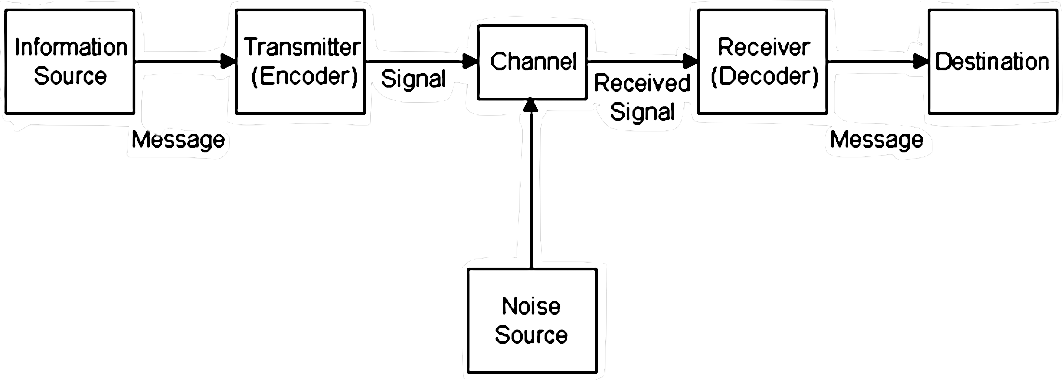
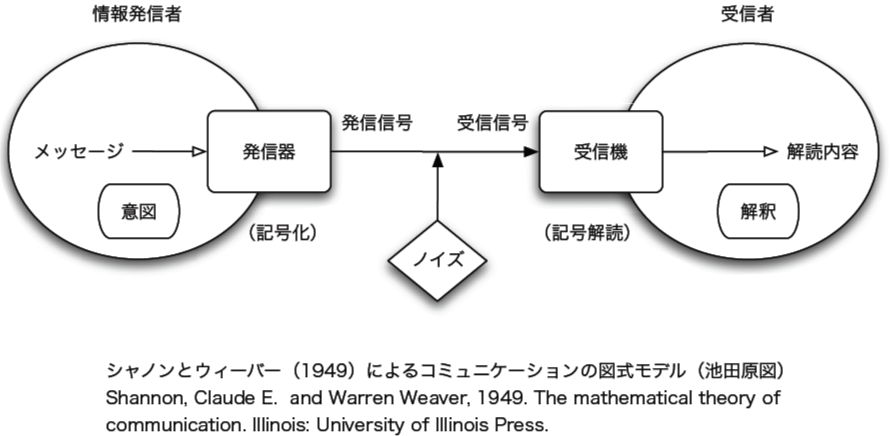
すなわち、コミュニケーション能力とは、 メッセージの伝送のことであり、それは一生かけてもよいものであり、また0.5秒で済ましてあとは気に せず、それに関わる必要のないものである。言い方を変えると、すばらしいヒューマン・コミュニケーション能力とは、送るべき相手をふさわしいタイミングで 判断し、的確に送り届ける能力ということである。
そして、コロナ時代にコミュニケーション 能力をつける方法?そんな奥義(the secret)などはない。学生のみなさんにできることは、(1)あらゆる手段をつかって、いろいろなところに、自分に関する情報を「上手に加工してか ら」伝送しなさい。次に(2)先方からの情報を到来を待ちなさい。その際に、世の中には、君の情報をうまく掠めとって悪用したり、君のプライバシーをいろ いろなところに晒したりする悪者に気をつけなさい。先生や先輩だかからといってまともとは限りません。ビジンやイケメンも同じ。相手は君のことが知りたく て接触してくるのではない、君から搾取しようとするからね。そして、(3)信頼できる相手と、すこしづつ情報のギャップを埋めなさい。もちろん、刎頚の友 のも「銭の切れ目が縁の切れ目」という言葉があるように、どこかで計算しているはずだ——そしてもちろん君もコミュニケーションの損得勘定を勘案しなくて はならない。したがって(4)人はなぜコミュニケーションをしたがるのか?それは、自分自身を知るためにおこなうのだ。
| In
telecommunications, packet switching
is a method of grouping data into packets that are transmitted over a
digital network. Packets are made of a header and a payload. Data in
the header is used by networking hardware to direct the packet to its
destination, where the payload is extracted and used by an operating
system, application software, or higher layer protocols. Packet
switching is the primary basis for data communications in computer
networks worldwide. During the early 1960s, American engineer Paul Baran developed a concept he called distributed adaptive message block switching, with the goal of providing a fault-tolerant, efficient routing method for telecommunication messages as part of a research program at the RAND Corporation, funded by the United States Department of Defense. His ideas contradicted then-established principles of pre-allocation of network bandwidth, exemplified by the development of telecommunications in the Bell System. The new concept found little resonance among network implementers until the independent work of Welsh computer scientist Donald Davies at the National Physical Laboratory in 1965. Davies coined the modern term packet switching and inspired numerous packet switching networks in the decade following, including the incorporation of the concept into the design of the ARPANET in the United States and the CYCLADES network in France. The ARPANET and CYCLADES were the primary precursor networks of the modern Internet. |
電気通信において、パケット交換とは、データをパケットにまとめ、デジ
タル・ネットワーク上で伝送する方法である。パケットはヘッダーとペイロードで構成される。ヘッダーのデータは、ネットワーク・ハードウェアがパケットを
宛先に導くために使用し、ペイロードはオペレーティング・システム、アプリケーション・ソフトウェア、または上位レイヤーのプロトコルが取り出して使用す
る。パケット交換は、世界中のコンピュータネットワークにおけるデータ通信の主要な基盤となっている。 1960年代初頭、アメリカのエンジニアであるポール・バランは、米国国防総省の資金提供を受けたランド・コーポレーションの研究プログラムの一環とし て、通信メッセージのフォールト・トレラントで効率的なルーティング方法を提供することを目的に、分散適応型メッセージ・ブロック・スイッチングと呼ばれ るコンセプトを開発した。彼の考えは、ベルシステムにおける電気通信の発展に代表される、ネットワーク帯域幅の事前割り当てという当時確立されていた原則 に反するものだった。この新しいコンセプトは、1965年にウェールズのコンピュータ科学者ドナルド・デイビーズが国立物理研究所で独立した研究を行うま で、ネットワーク実装者の間でほとんど共感を得られなかった。デイヴィスはパケットスイッチングという現代的な用語を作り出し、米国のARPANETやフ ランスのCYCLADESネットワークの設計にこのコンセプトを取り入れるなど、その後の10年間に数多くのパケットスイッチングネットワークに影響を与 えた。ARPANETとCYCLADESは、現代のインターネットの主要な前身ネットワークである。 |
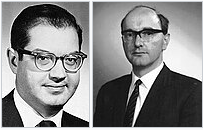 |
Paul Baran and Donald Davies
independently invented the concept of digital packet switching used in
modern computer networking including the Internet.[1][2][3] ポール・バランとドナルド・デイヴィスは、インターネットを含む現代のコンピューターネットワーキングに使われているデジタルパケットスイッチングの概念 を独自に発明した[1][2][3]。 |
Concept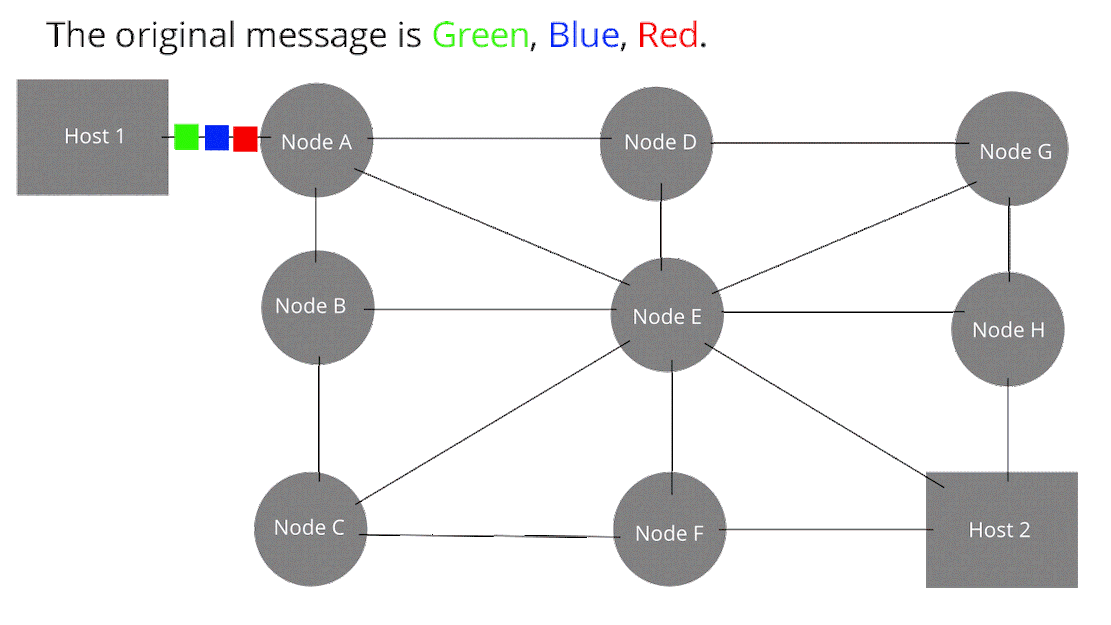 This animation illustrates a network model in which consecutive packets between hosts take differing routes. Out-of-order delivery is however detrimental to the performance of several network protocols, including TCP, so that the Internet attempts to route packets associated with the same data stream along the same path most of the time.[4] A simple definition of packet switching is: The routing and transferring of data by means of addressed packets so that a channel is occupied during the transmission of the packet only, and upon completion of the transmission the channel is made available for the transfer of other traffic.[5][6] Packet switching allows delivery of variable bit rate data streams, realized as sequences of packets, over a computer network which allocates transmission resources as needed using statistical multiplexing or dynamic bandwidth allocation techniques. As they traverse networking hardware, such as switches and routers, packets are received, buffered, queued, and retransmitted (stored and forwarded), resulting in variable latency and throughput depending on the link capacity and the traffic load on the network. Packets are normally forwarded by intermediate network nodes asynchronously using first-in, first-out buffering, but may be forwarded according to some scheduling discipline for fair queuing, traffic shaping, or for differentiated or guaranteed quality of service, such as weighted fair queuing or leaky bucket. Packet-based communication may be implemented with or without intermediate forwarding nodes (switches and routers). In case of a shared physical medium (such as radio or 10BASE5), the packets may be delivered according to a multiple access scheme. Packet switching contrasts with another principal networking paradigm, circuit switching, a method which pre-allocates dedicated network bandwidth specifically for each communication session, each having a constant bit rate and latency between nodes. In cases of billable services, such as cellular communication services, circuit switching is characterized by a fee per unit of connection time, even when no data is transferred, while packet switching may be characterized by a fee per unit of information transmitted, such as characters, packets, or messages. A packet switch has four components: input ports, output ports, routing processor, and switching fabric.[7] |
コンセプト このアニメーションは、ホスト間で連続するパケットが異なる経路を通るネットワークモデルを示している。しかし、順不同の配送はTCPを含むいくつかの ネットワークプロトコルのパフォーマンスにとって有害であるため、インターネットは同じデータストリームに関連するパケットをほとんどの場合同じ経路で ルーティングしようとする[4]。 パケット交換の簡単な定義は次のとおりである: アドレス指定されたパケットによってデータをルーティングし転送することで、パケットの転送中だけチャネルが占有され、転送が完了するとチャネルは他のト ラフィックの転送のために利用できるようになる[5][6]。 パケット交換は、パケットのシーケンスとして実現される可変ビットレートのデータストリームを、統計的多重化または動的帯域幅割り当て技術を使用して必要 に応じて伝送リソースを割り当てるコンピュータネットワーク上で配信することを可能にする。パケットはスイッチやルーターなどのネットワーキング・ハード ウェアを通過する際に、受信、バッファリング、キューイング、再送信(保存、転送)され、その結果、リンク容量やネットワーク上のトラフィック負荷に応じ て遅延やスループットが変化する。パケットは通常、中間ネットワークノードによって、先入れ先出しバッファリングを使用して非同期に転送されるが、公平な キューイング、トラフィックシェーピング、または重み付けされた公平なキューイングやリーキーバケットなどの差別化されたサービス品質や保証されたサービ ス品質のために、何らかのスケジューリング規律に従って転送されることもある。パケットベースの通信は、中間転送ノード(スイッチやルータ)の有無にかか わらず実装される。共有物理媒体(無線や10BASE5など)の場合、パケットは多重アクセス方式に従って配信される。 パケット交換は、もう一つの主要なネットワーキングのパラダイムである回線交換とは対照的である。回線交換は、専用のネットワーク帯域幅を各通信セッショ ンに特別に事前に割り当てる方式であり、各通信セッションは一定のビットレートとノード間の待ち時間を持つ。セルラー通信サービスのような課金サービスの 場合、回線交換は、データが転送されなくても、接続時間の単位あたりの料金で特徴付けられるが、パケット交換は、文字、パケット、メッセージなど、転送さ れる情報の単位あたりの料金で特徴付けられる。 パケットスイッチには、入力ポート、出力ポート、ルーティングプロセッサ、スイッチングファブリックの4つのコンポーネントがある[7]。 |
| History Further information: History of the Internet and Protocol Wars See also: Datagram § History Invention and development  The "message block", designed by Paul Baran in 1962 and refined in 1964, is the first proposal of a data packet.[8][9] 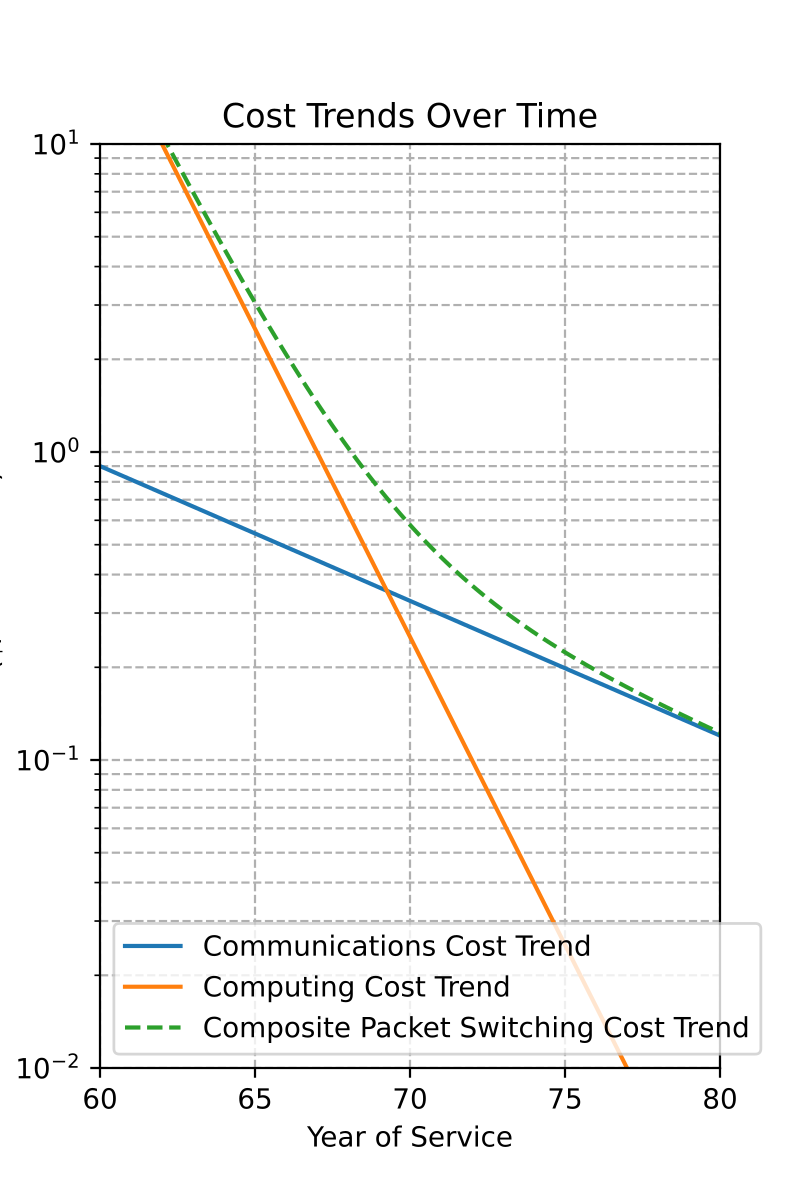 Packet-switching cost performance trends, 1960-1980.[10] The concept of switching small blocks of data was first explored independently by Paul Baran at the RAND Corporation during the early 1960s in the US and Donald Davies at the National Physical Laboratory (NPL) in the UK in 1965.[1][2][3][11] In the late 1950s, the US Air Force established a wide area network for the Semi-Automatic Ground Environment (SAGE) radar defense system. Recognizing vulnerabilities in this network, the Air Force sought a system that might survive a nuclear attack to enable a response, thus diminishing the attractiveness of the first strike advantage by enemies (see Mutual assured destruction).[12] In the early 1960s, Baran invented the concept of distributed adaptive message block switching in support of the Air Force initiative.[13][14] The concept was first presented to the Air Force in the summer of 1961 as briefing B-265,[12] later published as RAND report P-2626 in 1962,[8] and finally in report RM 3420 in 1964.[9] The reports describe a general architecture for a large-scale, distributed, survivable communications network. The proposal was composed of three key ideas: use of a decentralized network with multiple paths between any two points; dividing user messages into message blocks; and delivery of these messages by store and forward switching.[13][15] Baran's network design was focused on digital communication of voice and telex messages using switches that were low-cost electronics.[16][17][18] Christopher Strachey, who became Oxford University's first Professor of Computation, filed a patent application in the United Kingdom for time-sharing in February 1959.[19][20] In June that year, he gave a paper "Time Sharing in Large Fast Computers" at the UNESCO Information Processing Conference in Paris where he passed the concept on to J. C. R. Licklider.[21][22] Licklider (along with John McCarthy) was instrumental in the development of time-sharing. After conversations with Licklider about time-sharing with remote computers in 1965,[23][24] Davies independently invented a similar data communication concept to Baran and went on to develop a more advanced design for a hierarchical, high-speed computer network including interface computers and communication protocols.[25][26][27] He coined the term packet switching, and proposed building a commercial nationwide data network in the UK.[28][29] He gave a talk on the proposal in 1966, after which a person from the Ministry of Defence (MoD) told him about Baran's work.[30] Roger Scantlebury, a member of Davies' team, presented their work (and referenced that of Baran) at the October 1967 Symposium on Operating Systems Principles (SOSP).[27][31][32][33][34] At the conference, Scantlebury proposed packet switching for use in the ARPANET and persuaded Larry Roberts the economics were favorable to message switching.[35][36][37][38][39][40] Davies had chosen some of the same parameters for his original network design as did Baran, such as a packet size of 1024 bits. To deal with packet permutations (due to dynamically updated route preferences) and datagram losses (unavoidable when fast sources send to a slow destinations), he assumed that "all users of the network will provide themselves with some kind of error control",[27] thus inventing what came to be known as the end-to-end principle. Davies proposed that a local-area network should be built at the laboratory to serve the needs of NPL and prove the feasibility of packet switching. After a pilot experiment in early 1969,[41][42][43][44] the NPL Data Communications Network began service in 1970.[45] The NPL team carried out simulation work on datagrams and congestion in networks on a scale to provide data communication across the United Kingdom.[44][46][47][48][49] Larry Roberts made the key decisions in the request for proposal to build the ARPANET.[50] Roberts met Baran in February 1967, but did not discuss networks.[51][52] He asked Frank Westervelt to explore the questions of message size and contents for the network, and to write a position paper on the intercomputer communication protocol including “conventions for character and block transmission, error checking and re transmission, and computer and user identification."[53] Roberts revised his initial design, which was to connect the host computers directly, to incorporate Wesley Clark's idea to use Interface Message Processors (IMPs) to create a message switching network, which he presented at SOSP.[54][55][56][57] Roberts was known for making decisions quickly.[58] Immediately after SOSP, he incorporated Davies' and Baran's concepts and designs for packet switching to enable the data communications on the network.[37][59][60][61] A contemporary of Roberts' from MIT, Leonard Kleinrock had researched the application of queueing theory in the field of message switching for his doctoral dissertation in 1961–62 and published it as a book in 1964.[62] Larry Roberts brought Kleinrock into the ARPANET project informally in early 1967.[63] After SOSP, and after Roberts' direction to use packet switching,[59] Kleinrock sought input from Baran and proposed to retain Baran and RAND as advisors.[64][65][66] The ARPANET working group assigned Kleinrock responsibility to prepare a report on software for the IMP.[67] In 1968, Roberts awarded Kleinrock a contract to establish a Network Measurement Center (NMC) at UCLA to measure and model the performance of packet switching in the ARPANET.[64] Bolt Beranek & Newman (BBN) won the contract to build the network. Designed principally by Bob Kahn,[68][69] it was the first wide-area packet-switched network with distributed control.[50] The BBN "IMP Guys" independently developed significant aspects of the network's internal operation, including the routing algorithm, flow control, software design, and network control.[70][71] The UCLA NMC and the BBN team also investigated network congestion.[68][72] The Network Working Group, led by Steve Crocker, a graduate student of Kleinrock's at UCLA, developed the host-to-host protocol, the Network Control Program, which was approved by Barry Wessler for ARPA.[73] In 1970, Kleinrock extended his earlier analytic work on message switching to packet switching in the ARPANET.[74] His work influenced the development of the ARPANET and packet-switched networks generally.[75][76][77] The ARPANET was demonstrated at the International Conference on Computer Communication (ICCC) in Washington in October 1972.[78][79] However, fundamental questions about the design of packet-switched networks remained.[80][81][82] Roberts presented the idea of packet switching to communication industry professionals in the early 1970s. Before ARPANET was operating, they argued that the router buffers would quickly run out. After the ARPANET was operating, they argued packet switching would never be economic without the government subsidy. Baran had faced the same rejection and thus failed to convince the military into constructing a packet switching network in the 1960s.[10] The CYCLADES network was designed by Louis Pouzin in the early 1970s to study internetworking.[83][84] It was the first to implement the end-to-end principle of Davies, and make the hosts responsible for the reliable delivery of data on a packet-switched network, rather than this being a service of the network itself.[85] His team was thus first to tackle the highly-complex problem of providing user applications with a reliable virtual circuit service while using a best-effort service, an early contribution to what will be the Transmission Control Protocol (TCP).[86] Bob Metcalfe and others at Xerox PARC outlined the idea of Ethernet and the PARC Universal Packet (PUP) for internetworking.[87] In May 1974, Vint Cerf and Bob Kahn described the Transmission Control Program, an internetworking protocol for sharing resources using packet-switching among the nodes.[88] The specifications of the TCP were then published in RFC 675 (Specification of Internet Transmission Control Program), written by Vint Cerf, Yogen Dalal and Carl Sunshine in December 1974.[89] The X.25 protocol, developed by Rémi Després and others, was built on the concept of virtual circuits. In the mid-late 1970s and early 1980s, national and international public data networks emerged using X.25. It was complemented with X.75 to enable internetworking.[90] In the late 1970s, the monolithic Transmission Control Program was layered as the Transmission Control Protocol, TCP, atop the Internet Protocol, IP. Many researchers developed this into the Internet protocol suite and the associated Internet architecture and governance that emerged in the 1980s.[91][92][93][94][95][96] For a period in the 1980s and early 1990s, the network engineering community was polarized over the implementation of competing protocol suites, commonly known as the Protocol Wars. It was unclear which of the Internet protocol suite and the OSI model would result in the best and most robust computer networks.[97][98][99] Leonard Kleinrock's research work during the 1970s addressed packet switching networks, packet radio networks, local area networks, broadband networks, nomadic computing, peer-to-peer networks, and intelligent software agents.[100][101] His theoretical work on hierarchical routing with student Farouk Kamoun became critical to the operation of the Internet.[102][103] Kleinrock published hundreds of research papers,[104][105] which ultimately launched a new field of research on the theory and application of queuing theory to computer networks.[74][106] Complementary metal–oxide–semiconductor (CMOS) VLSI (very-large-scale integration) technology led to the development of high-speed broadband packet switching during the 1980s–1990s.[107][108][109] The "paternity dispute" In 1997, along with eight other Internet pioneers, Leonard Kleinrock co-wrote "Brief History of the Internet" published by the Internet Society.[110] In it, Kleinrock is described as having "published the first paper on packet switching theory in July 1961 and the first book on the subject in 1964". This claim later became the subject of what Katie Hafner called a "paternity dispute" in The New York Times in 2001.[111] The disagreement about Kleinrock's contribution to packet switching dates back to a version of the above claim made on Kleinrock's profile on the UCLA Computer Science department website sometime in the 1990s. Here, he was referred to as the "Inventor of the Internet Technology".[112] The webpage's depictions of Kleinrock's achievements provoked anger among some early Internet pioneers.[113] The dispute over priority became a public issue after Donald Davies posthumously published a paper in 2001 in which he denied that Kleinrock's work was related to packet switching. Davies also described ARPANET project manager Larry Roberts as supporting Kleinrock, referring to Roberts' writings online and Kleinrock's UCLA webpage profile as "very misleading".[114][115] Walter Isaacson wrote that Kleinrock's claims "led to an outcry among many of the other Internet pioneers, who publicly attacked Kleinrock and said that his brief mention of breaking messages into smaller pieces did not come close to being a proposal for packet switching".[113] Davies' paper reignited a previous dispute over who deserves credit for getting the ARPANET online between engineers at Bolt, Beranek, and Newman (BBN) who had been involved in building and designing the ARPANET IMP on the one side, and ARPA-related researchers on the other.[70][71] This earlier dispute is exemplified by BBN's Will Crowther, who in a 1990 oral history described Paul Baran's packet switching design (which he called hot-potato routing), as "crazy" and non-sensical, despite the ARPA team having advocated for it.[116] The reignited debate caused other former BBN employees to make their concerns known, including Alex McKenzie, who followed Davies in disputing that Kleinrock's work was related to packet switching, stating "... there is nothing in the entire 1964 book that suggests, analyzes, or alludes to the idea of packetization".[117] Former IPTO director Bob Taylor also joined the debate, stating that "authors who have interviewed dozens of Arpanet pioneers know very well that the Kleinrock-Roberts claims are not believed".[118] Walter Isaacson notes that "until the mid-1990s Kleinrock had credited [Baran and Davies] with coming up with the idea of packet switching".[113] A subsequent version of Kleinrock's biography webpage was copyrighted in 2009 by Kleinrock.[119] He was called on to defend his position over subsequent decades.[120] In 2023, he acknowledged that his published work in the early 1960s was about message switching and claimed he was thinking about packet switching.[121] Historians recognize Baran and Davies for independently inventing the concept of digital packet switching used in modern computer networking including the Internet.[1][2][37][122][123] Kleinrock has received many awards for his ground-breaking applied mathematical research on packet switching, carried out in the 1970s, which was an extension of his pioneering work in the early 1960s on the optimization of message delays in communication networks.[74][124] However, Kleinrock's claims that his work in the early 1960s originated the concept of packet switching and that his work was a source of the packet switching concepts used in the ARPANET have affected sources on the topic, which has created methodological challenges in the historiography of the Internet.[111][113][115][120] Historian Andrew L. Russell said "'Internet history' ... tends to be too close to its sources. Many Internet pioneers are alive, active, and eager to shape the histories that describe their accomplishments. Many museums and historians are equally eager to interview the pioneers and to publicize their stories".[125] |
沿革 さらに詳しい情報 インターネットの歴史とプロトコル戦争 も参照のこと: データグラム§歴史 発明と開発  1962年にポール・バランによって設計され、1964年に改良された「メッセージブロック」は、データパケットの最初の提案である[8][9]。  パケット交換のコストパフォーマンスの推移、1960年~1980年[10]。 小さなデータブロックをスイッチングするというコンセプトは、1960年代初頭に米国のランド研究所でポール・バランによって、1965年に英国の国立物 理研究所(NPL)でドナルド・デイビスによって、それぞれ独自に研究された[1][2][3][11]。 1950年代後半、アメリカ空軍は半自動地上環境(SAGE)レーダー防衛システムのための広域ネットワークを構築した。このネットワークの脆弱性を認識 していた空軍は、核攻撃を受けても応答を可能にするために生き残る可能性のあるシステムを模索し、その結果、敵による先制攻撃の優位性の魅力を減少させた (相互確証破壊を参照)[12] 1960年代初頭、バランは空軍のイニシアチブを支援するために分散適応型メッセージブロックスイッチングの概念を発明した。 [このコンセプトは1961年の夏にブリーフィングB-265として空軍に初めて提示され[12]、後に1962年にランド研究所報告書P-2626とし て発表され[8]、最終的には1964年に報告書RM 3420として発表された[9]。バランのネットワーク設計は、低コストの電子機器であるスイッチを使用した音声およびテレックスメッセージのデジタル通 信に焦点を当てていた[16][17][18]。 オックスフォード大学の最初の計算機教授となったクリストファー・ストラチーは、1959年2月にタイムシェアリングに関する特許を英国に出願した [19][20]。 同年6月、彼はパリで開催されたユネスコ情報処理会議において「大型高速コンピュータにおけるタイムシェアリング」という論文を発表し、そのコンセプトを J.C.R.リックライダーに伝えた[21][22]。 リックライダーは(ジョン・マッカーシーとともに)タイムシェアリングの発展に貢献した。1965年にリモートコンピュータとのタイムシェアリングについ てリックライダーと会話した後[23][24]、デイヴィスはバランと同様のデータ通信コンセプトを独自に発明し、インターフェイスコンピュータと通信プ ロトコルを含む階層的な高速コンピュータネットワークのより高度な設計を開発した。 [25][26][27]彼はパケットスイッチングという用語を作り出し、英国における商業的な全国データネットワークの構築を提案した[28] [29]。彼は1966年にこの提案に関する講演を行い、その後、国防省(MoD)の関係者がバランの研究について彼に伝えた。 [30]デイヴィスのチームのメンバーであるロジャー・スカントルベリーは、1967年10月のオペレーティングシステム原理シンポジウム(SOSP)で 彼らの研究(とバランの研究を参照)を発表した。 [27][31][32][33][34]この会議で、ScantleburyはARPANETで使用するパケット交換を提案し、Larry Robertsにメッセージ交換よりも経済的に有利であることを説得した[35][36][37][38][39][40]。Daviesは、パケットサ イズを1024ビットにするなど、Baranと同じパラメータを元のネットワーク設計にいくつか選択していた。パケットの並べ替え(動的に更新される経路 設定による)とデータグラムの損失(高速な送信元が低速な宛先に送信する場合に避けられない)に対処するために、彼は「ネットワークのすべてのユーザが自 分自身に何らかのエラー制御を提供する」と仮定し[27]、エンドツーエンドの原理として知られるようになったものを発明した。Daviesは、NPLの ニーズに対応し、パケット交換の実現可能性を証明するために、研究所にローカルエリアネットワークを構築することを提案した。1969年初頭のパイロット 実験の後[41][42][43][44]、NPLデータ通信ネットワークは1970年にサービスを開始した[45]。NPLチームは、英国全土にデータ 通信を提供する規模のネットワークにおけるデータグラムと輻輳に関するシミュレーション作業を実施した[44][46][47][48][49]。 ラリー・ロバーツはARPANETを構築するための提案依頼の中で重要な決定を行った[50]。 ロバーツは1967年2月にバランに会ったが、ネットワークについては議論しなかった[51][52]。 ロバーツはフランク・ウェスターベルトに、ネットワークのメッセージサイズと内容の問題を検討し、「文字とブロックの送信、エラーチェックと再送信、コン ピュータとユーザーの識別に関する規約」を含むコンピュータ間通信プロトコルに関するポジションペーパーを書くように依頼した。 「ロバーツはホストコンピュータを直接接続するという当初の設計を修正し、メッセージ交換ネットワークを構築するためにインターフェースメッセージプロ セッサ(IMP)を使用するというウェスリー・クラークのアイデアを取り入れ、SOSPで発表した[54][55][56][57]。 ロバーツは決断が早いことで知られていた[58]。SOSPの直後に、ネットワーク上のデータ通信を可能にするために、デイヴィスとバランのパケット交換 のコンセプトと設計を取り入れた[37][59][60][61]。 MIT時代のロバーツと同世代のレナード・クラインロックは、1961年から62年にかけて博士論文としてメッセージ交換の分野における待ち行列理論の応 用を研究し、1964年に書籍として出版した[62]。 [1968年、ロバーツはクラインロックに、ARPANETにおけるパケットスイッチングの性能を測定しモデル化するために、UCLAにネットワーク測定 センター(NMC)を設立する契約を与えた[64]。 ボルト・ベラネック&ニューマン(BBN)がネットワーク構築の契約を獲得した。主にボブ・カーンによって設計され[68][69]、分散制御を備えた最 初の広域パケット交換ネットワークであった[50]。BBNの「IMPガイズ」は、ルーティングアルゴリズム、フロー制御、ソフトウェア設計、ネットワー ク制御を含む、ネットワーク内部動作の重要な側面を独自に開発した[70][71]。 [1970年、クラインロックはメッセージ交換に関する初期の分析的研究をARPANETのパケット交換に拡張した[74]。 ARPANETは1972年10月にワシントンで開催された国際コンピュータ通信会議(ICCC)でデモンストレーションされた[78][79]。 ロバーツは1970年代初頭にパケット交換のアイデアを通信業界の専門家に提示した。ARPANETが運用される前、彼らはルータのバッファはすぐになく なってしまうと主張した。ARPANETが稼働した後、彼らはパケット交換は政府の補助金なしでは決して経済的ではないと主張した。バランは同じ拒絶に直 面したため、1960年代にパケット交換ネットワークを構築するよう軍を説得することに失敗した[10]。 CYCLADESネットワークは、インターネットワーキングを研究するために1970年代初頭にルイ・プーザンが設計したものであった[83][84]。 Daviesのエンドツーエンドの原則を実装し、パケット交換ネットワーク上のデータの信頼性の高い配信を、ネットワーク自体のサービスではなく、ホスト に責任を持たせた最初のものであった[85]。 ゼロックスPARCのボブ・メトカーフらは、インターネットワーキングのためのイーサネットとPARCユニバーサルパケット(PUP)のアイデアを概説し た[87]。 1974年5月、ヴィント・サーフとボブ・カーンは、ノード間でパケット交換を使用してリソースを共有するためのインターネットワーキングプロトコルであ る伝送制御プログラムについて説明した[88]。TCPの仕様は、1974年12月にヴィント・サーフ、ヨーゲン・ダラル、カール・サンシャインによって 書かれたRFC 675(Specification of Internet Transmission Control Program)で公開された[89]。 Rémi Desprésらによって開発されたX.25プロトコルは、仮想回路の概念に基づいて構築された。1970年代後半から1980年代前半にかけて、 X.25を使用した国内および国際的な公共データネットワークが出現した。これはインターネットワーキングを可能にするためにX.75で補完された [90]。 1970年代後半、モノリシックな伝送制御プログラムが伝送制御プロトコル(TCP)としてインターネットプロトコル(IP)の上にレイヤー化された。多 くの研究者がこれをインターネット・プロトコル・スイートへと発展させ、1980年代に登場した関連するインターネット・アーキテクチャとガバナンスを構 築した[91][92][93][94][95][96]。 1980年代から1990年代初頭の一時期、ネットワークエンジニアリングコミュニティは、一般的にプロトコル戦争として知られる、競合するプロトコルス イートの実装をめぐって二極化した。インターネット・プロトコル・スイートとOSIモデルのうち、どれが最良で最も堅牢なコンピュータ・ネットワークにな るかは不明確だった[97][98][99]。 レナード・クラインロックは1970年代にパケット交換ネットワーク、パケット無線ネットワーク、ローカルエリアネットワーク、ブロードバンドネットワー ク、ノマディックコンピューティング、ピアツーピアネットワーク、インテリジェントソフトウェアエージェントに関する研究を行っていた[100] [101]。学生のファルク・カムーンとの階層ルーティングに関する理論的な研究は、インターネットの運用に不可欠なものとなった[102][103]。 相補型金属-酸化膜-半導体(CMOS)VLSI(超大規模集積)技術は、1980年代から1990年代にかけて高速ブロードバンドパケットスイッチング の開発につながった[107][108][109]。 "父子論争" 1997年、レナード・クラインロックは、他の8人のインターネットのパイオニアとともに、インターネット協会によって出版された "Brief History of the Internet "を共著した[110]。その中で、クラインロックは「1961年7月にパケット交換理論に関する最初の論文を発表し、1964年にこのテーマに関する最 初の本を出版した」と記述されている。この主張は後に、2001年のニューヨークタイムズ紙でケイティ・ハフナーが「父子論争」と呼ぶ主題となった [111]。 パケットスイッチングに対するクラインロックの貢献に関する意見の相違は、1990年代のある時期にUCLAコンピュータサイエンス学部のウェブサイトに 掲載されたクラインロックのプロフィールに記載された上記の主張のバージョンにまでさかのぼる。このウェブページのクラインロックの業績に関する描写は、 初期のインターネットのパイオニアたちの怒りを買った[113]。 この優先順位をめぐる論争は、2001年にドナルド・デイビースが、クラインロックの仕事がパケット交換に関連していることを否定する論文を死後に発表し た後、公の問題となった。デイヴィスはまた、ARPANETのプロジェクトマネージャーであるラリー・ロバーツがクラインロックを支持しているとし、ロ バーツのオンライン上の文章やクラインロックのUCLAのウェブページのプロフィールを「非常に誤解を招く」と述べている[114][115]。ウォル ター・アイザックソンは、クラインロックの主張が「他のインターネットのパイオニアの多くの反発を招き、彼らはクラインロックを公に攻撃し、メッセージを より小さな断片に分割するという彼の短い言及はパケットスイッチングの提案にはほど遠かった」と書いている[113]。 Daviesの論文は、ARPANET IMPの構築と設計に関与していたBolt, Beranek, and Newman (BBN)のエンジニアとARPA関連の研究者の間で、ARPANETをオンラインにした功績を誰が称えるべきかという以前の論争を再燃させた[70] [71]。 この以前の論争は、BBNのウィル・クラウザーが1990年のオーラルヒストリーの中で、ARPAチームが提唱したにもかかわらず、ポール・バランのパ ケットスイッチング設計(彼はホットポテトルーティングと呼んでいた)を「クレイジー」で非理にかなっていると評したことに象徴される[70][71]。 [116]議論が再燃したことで、アレックス・マッケンジー(Alex McKenzie)ら他の元BBN従業員も懸念を表明するようになった。アレックスは、デイビーズに続いて、クラインロックの仕事がパケットスイッチング に関連していることに異議を唱え、「...1964年の本全体には、パケット化のアイデアを示唆、分析、暗示するものは何もない」と述べた[117]。 元IPTOのディレクターであるボブ・テイラーもこの議論に加わり、「何十人ものアーパネットのパイオニアにインタビューした著者たちは、クラインロック とロバーツの主張が信じられていないことをよく知っている」と述べている[118]。ウォルター・アイザックソンは、「1990年代半ばまで、クライン ロックはパケットスイッチングのアイデアを思いついたのは[バランとデイビーズ]だと信じていた」と指摘している[113]。 クラインロックの伝記のウェブページのその後のバージョンは、クラインロックによって2009年に著作権で保護されている[119]。 その後数十年にわたって、彼は自分の立場を擁護するよう求められていた[120]。 2023年に、彼は1960年代初頭に発表した仕事がメッセージスイッチングに関するものであったことを認め、パケットスイッチングについて考えていたと 主張している[121]。 歴史家は、インターネットを含む現代のコンピュータネットワークで使用されているデジタルパケットスイッチングの概念を独自に発明したことについて、バラ ンとデイヴィスを認めている[1][2][37][122][123]。 クラインロックは、通信ネットワークにおけるメッセージ遅延の最適化に関する1960年代初期の先駆的な研究の延長線上にある、1970年代に実施された パケットスイッチングに関する画期的な応用数学的研究により、多くの賞を受賞している[74][124]。 [しかし、1960年代初頭の彼の研究がパケット交換の概念の起源であり、彼の研究がARPANETで使用されたパケット交換の概念の源であるというクラ インロックの主張は、このトピックに関する情報源に影響を与えており、インターネットの歴史学において方法論的な課題を生み出している[111] [113][115][120]。歴史家のアンドリュー・L・ラッセルは「『インターネット史』は......その情報源に近すぎる傾向がある。インター ネットのパイオニアの多くは生きており、活動的であり、彼らの業績を記述する歴史を形成することに熱心である。多くの博物館や歴史家も同様に、パイオニア にインタビューし、彼らのストーリーを公表することを熱望している」と述べている[125]。 |
| https://en.wikipedia.org/wiki/Packet_switching |
|
| Bibliography Abbate, Janet (2000). Inventing the Internet. MIT Press. ISBN 9780262511155. Gillies, James; Cailliau, Robert (2000). How the Web was born : the story of the World Wide Web. Oxford: Oxford University Press. ISBN 0-19-286207-3. OCLC 43377073. Hafner, Katie (1996). Where Wizards Stay Up Late. Simon and Schuster. pp. 52–67. ISBN 9780684832678. Norberg, Arthur; O'Neill, Judy E. (2000). Transforming Computer Technology: Information Processing for the Pentagon, 1962-1982. Johns Hopkins University. ISBN 978-0801863691. Moschovitis, Christos J. P. (1999). History of the Internet: A Chronology, 1843 to the Present. ABC-CLIO. ISBN 978-1-57607-118-2. Lawrence Roberts, The Evolution of Packet Switching (Proceedings of the IEEE, November, 1978) Primary sources Paul Baran et al., On Distributed Communications, Volumes I-XI Archived 2011-03-29 at the Wayback Machine (RAND Corporation Research Documents, August, 1964) Paul Baran, On Distributed Communications: I Introduction to Distributed Communications Network (RAND Memorandum RM-3420-PR. August 1964) Paul Baran, On Distributed Communications Networks, (IEEE Transactions on Communications Systems, Vol. CS-12 No. 1, pp. 1–9, March 1964) D. W. Davies, K. A. Bartlett, R. A. Scantlebury, and P. T. Wilkinson, A digital communications network for computers giving rapid response at remote terminals (ACM Symposium on Operating Systems Principles. October 1967) R. A. Scantlebury, P. T. Wilkinson, and K. A. Bartlett, The design of a message switching Centre for a digital communication network (IFIP 1968) |
参考文献 アッベート、ジャネット(2000)。『インターネットの発明』。MITプレス。ISBN 9780262511155。 ギリーズ、ジェームズ;カイリオー、ロバート(2000)。『ウェブ誕生の物語:ワールド・ワイド・ウェブの軌跡』。オックスフォード:オックスフォード大学出版局。 ISBN 0-19-286207-3。OCLC 43377073。 ハフナー、ケイティ(1996)。『ウィザードたちが夜更かしする場所』。サイモン・アンド・シュスター。52-67 ページ。ISBN 9780684832678。 ノーバーグ、アーサー、オニール、ジュディ E. (2000). 『コンピュータ技術の変容:1962年から1982年までの国防総省の情報処理』. ジョンズ・ホプキンズ大学. ISBN 978-0801863691. モスコヴィティス、クリストス J. P. (1999)。インターネットの歴史:年表、1843 年から現在まで。ABC-CLIO。ISBN 978-1-57607-118-2。 ローレンス・ロバーツ、パケット交換の進化 (IEEE 論文集、1978 年 11 月) 一次資料 ポール・バラン他、分散通信について、第 I 巻から第 XI 巻 2011年3月29日、ウェイバックマシンにアーカイブ (RAND Corporation Research Documents、1964年8月) ポール・バラン、分散通信について:I 分散通信ネットワークの紹介 (RAND Memorandum RM-3420-PR。1964年8月) ポール・バラン、分散通信ネットワークについて(IEEE Transactions on Communications Systems、Vol. CS-12 No. 1、pp. 1–9、1964年3月 D. W. デービス、K. A. バートレット、R. A. スカントルベリー、P. T. ウィルキンソン、遠隔端末で迅速な応答を行うコンピュータ用デジタル通信ネットワーク (ACM Symposium on Operating Systems Principles. October 1967) R. A. Scantlebury, P. T. Wilkinson, and K. A. Bartlett, The design of a message switching Centre for a digital communication network (IFIP 1968) |
| Further reading Pelkey, James L.; Russell, Andrew L.; Robbins, Loring G. (2022). Circuits, Packets, and Protocols: Entrepreneurs and Computer Communications, 1968-1988. Morgan & Claypool. ISBN 978-1-4503-9729-2. Russell, Andrew L. (2014). Open Standards and the Digital Age: History, Ideology, and Networks. Cambridge University Press. ISBN 978-1-139-91661-5. |
参考文献 Pelkey, James L.; Russell, Andrew L.; Robbins, Loring G. (2022). Circuits, Packets, and Protocols: Entrepreneurs and Computer Communications, 1968-1988. Morgan & Claypool. ISBN 978-1-4503-9729-2. ラッセル、アンドルー L. (2014). 『オープンスタンダードとデジタル時代:歴史、イデオロギー、ネットワーク』. ケンブリッジ大学出版局. ISBN 978-1-139-91661-5. |
links
bibliography
other informations
We respect on The
Constitution of Japan, 1947. If you have any inconvenience of this
pape, please let know the author of the page via
rosaldo_[at]_cscd.osaka-u.ac.jp.
---------------------------------
****
Copyleft, CC, Mitzub'ixi Quq Chi'j, 1997-2099

++
Copyleft,
CC, Mitzub'ixi Quq Chi'j, 1996-2099